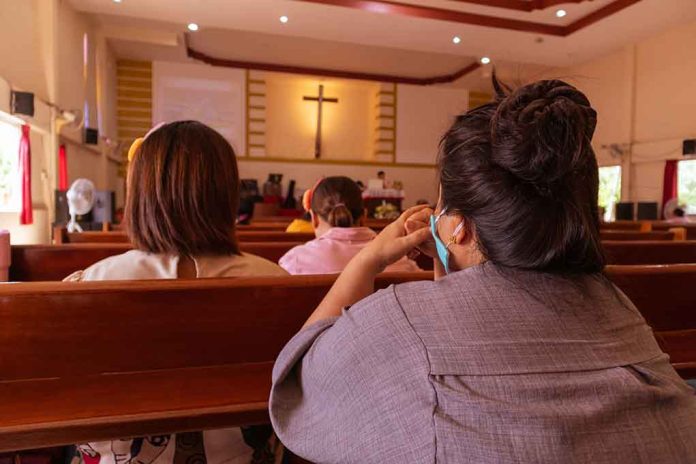
Hollywood’s recent thriller “Conclave” misrepresents papal elections as political warfare, portraying cardinals as liberal and conservative combatants rather than spiritual leaders discerning God’s will for the Church.
Key Takeaways
- The film “Conclave” takes significant creative liberties with the Vatican’s papal election process, presenting it as political infighting rather than spiritual discernment.
- Vatican experts strongly warn against using the movie as a guide to understanding real conclaves, with insider John Allen Jr. emphasizing “for the love of God, no.”
- While the film accurately captures some visual elements and procedures, it dramatically exaggerates political divisions and includes impossible scenarios like secret cardinals and vote-buying.
- The actual conclave process involves 135 cardinals under 80 from around the world, with a two-thirds majority requirement that prevents extreme candidates from being elected.
- Interest in the film has surged following Pope Francis’s death, though experts caution viewers about its “artfully deceptive” portrayal of Church governance.
Hollywood’s Distorted Vision of Vatican Politics
The 2024 political thriller “Conclave” presents viewers with a dramatized version of papal elections that bears only passing resemblance to reality. While visually striking with its high production values and A-list cast, the film fundamentally mischaracterizes the nature of the conclave process. Instead of depicting the prayerful discernment that guides the selection of a new pope, the movie portrays cardinals engaged in partisan warfare reminiscent of secular political campaigns, complete with backroom deals and character assassination.
“If we liberals are not united, Tedesco will become Pope … If Tedesco becomes pope, he will undo 60 years of progress,” says Stanley Tucci’s character, American Cardinal Aldo Bellini. When challenged with “defeat who? This is a conclave, Aldo. It’s not a war,” Bellini responds: “it is a war, and you have to commit to a side,“ shared in LifeSiteNews
This fictional portrayal stands in stark contrast to the actual conclave process. Vatican experts have been quick to dismiss the film as a misleading representation of how papal elections truly function. The stark liberal-versus-conservative framing oversimplifies the complex theological considerations and personal relationships that influence cardinal electors. In reality, conclaves operate with far more nuance and spiritual gravity than Hollywood suggests, focusing on discerning the best shepherd for the universal Church rather than advancing partisan agendas.
What “Conclave” Gets Right and Wrong
Despite its flaws, the film does capture some authentic elements of the conclave process. The attention to visual detail in recreating Vatican settings and ceremonial aspects has been praised by religious scholars who have viewed the film. The basic mechanics of the voting process are also portrayed with reasonable accuracy, although certain procedural details are altered for dramatic effect, such as the frequency of ballot burning, which happens after each session rather than each individual vote as shown in the movie.
“The film gets a lot right. They tried to reproduce the mise-en-scene of the Vatican accurately. They show that a lot of the drama is around the preconclave conversations among cardinals,” said William Cavanaugh via Crossroads Today
However, the film’s most egregious inaccuracies involve plot devices that would be impossible in an actual conclave. One major storyline revolves around a cardinal “in pectore” (appointed secretly by the pope without public announcement) participating in the election, which directly contradicts Church law. Similarly, scenes depicting a cardinal breaking the seal of confession and engaging in vote-buying present scandalous behaviors that would result in automatic excommunication under Canon Law. These fabrications serve the film’s thriller elements while severely misrepresenting the ethical standards of Vatican proceedings.
Vatican Insiders Reject Hollywood’s Fantasy
With renewed interest in the film following Pope Francis’s death, Vatican experts have been particularly vocal about warning viewers not to take “Conclave” as an accurate representation of Church governance. John Allen Jr., one of the most respected Vatican journalists, has offered a stinging rebuke of the film’s value as an educational tool about papal elections. His unequivocal dismissal underscores the gap between Hollywood storytelling and ecclesiastical reality, cautioning Catholics and non-Catholics alike against forming impressions based on fictionalized accounts.
“Your first question was, should you be looking to the movie ‘Conclave’ as a guide to what’s really going to happen when the cardinals meet to elect the pope? Short answer, no. Slightly longer answer, absolutely no. And a slightly longer answer than that, for the love of God, no,” said Vatican insider John Allen Jr. via Detroit News
Tom Hoopes, a Catholic writer and former editor, similarly criticized the film for prioritizing dramatic tension over accuracy. His description of the film as “artfully deceptive” points to the skillful way filmmakers have woven plausible elements with complete fabrications to create an engaging but misleading narrative. The real conclave process involves 135 cardinals under age 80 gathering from around the world, engaging in pre-conclave meetings to become acquainted with colleagues from diverse regions, and participating in a voting process that requires a two-thirds majority – a safeguard that prevents extreme candidates from ascending to the papacy.
“The movie is based on an ‘airplane novel,’ and that’s always dicey,” said Tom Hoopes via Detroit News
The Real Stakes of Papal Elections
While “Conclave” may exaggerate the political divisions within the College of Cardinals, legitimate discussions about the Church’s future direction do occur during actual conclaves. Currently, several cardinals are considered potential successors to Pope Francis, representing different theological perspectives. Cardinals like Matteo Zuppi and Pietro Parolin, characterized as more progressive, contrast with traditionalist voices like Cardinal Sarah of Africa and Cardinal Erdő of Hungary. These differences reflect genuine discernment about the Church’s response to modern challenges rather than the Machiavellian scheming depicted in the film.
“A long conclave would send the message of a Church divided and possibly on the verge of a schism. The history of the conclaves in the last century is really a story of short conclaves,” said Massimo Faggioli via Crossroads Today
For viewers intrigued by “Conclave,” it’s crucial to recognize the film as entertainment rather than education. The actual process of selecting a pope remains a deeply spiritual exercise conducted with prayer and discernment. While the film may spark interest in Vatican procedures, those seeking authentic understanding would be better served by consulting reputable sources on Catholic governance rather than relying on Hollywood’s dramatized version. As the real-world Church prepares for its next leadership transition, the true conclave will unfold with far more dignity and divine purpose than its cinematic counterpart suggests.







